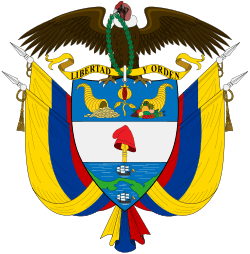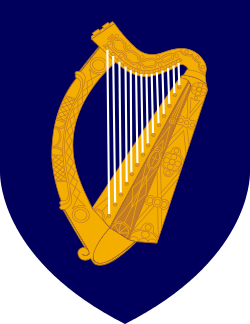Colombia–Ireland relations
 |
|
Colombia |
Ireland |
|---|---|
Colombia–Ireland relations are relations between Colombia and Ireland. Neither country has a resident ambassador. Colombia is represented in Ireland through its embassy in London, England. Ireland is represented in Colombia through its embassy in Mexico City, Mexico and an honorary consulate in Bogotá. The Irish have a long relationship with Colombia dating back to involvement by Irish volunteers in the Colombian wars of independence.[1]
Colombian independence
Irish volunteers played a central role in the wars in which Colombia gained independence from Spain. Between 1,000 and 2,000 Irish volunteers led by Irishmen such as William Aylmer, Francisco Burdett O'Connor and James Towers English assisted in the struggle. The Irish leader James Rooke led his British Legions with Simon Bolivar's army in its epic march from Eastern Venezuela across the plains and up into the Andes, where the Irish troops played a key role in the Vargas Swamp Battle and the subsequent decisive Battle of Boyacá. When offered laurels after the victory at Boyacá, Bolívar credited the victory at Boyacá to the English and Irish volunteers, declaring that "those soldier liberators are the men who deserve these laurels".[2] In the subsequent upheavals in Colombia in the 1820s, Irishmen such as Daniel Florence O'Leary, Arthur Sandes and John Johnston were among Bolívar's most faithful officers. The descendants of the Irish volunteers live in Colombia to this day.[3]
Legion of Mary
In a different form of relationship, the Catholic lay movement Legion of Mary founded in Dublin, Ireland, by layman Frank Duff sent Seamus Grace and Alphie Lamb to Bogotá in 1953 to expand their mission in Colombia. Grace and Lamb established Legion praesidia throughout the country. The Legion was well received in Colombia, especially by the poor, brought many people back to the Catholic faith, and later expanded to other parts of South America.[1][4]
IRA Incident
In 2001, Colombia arrested three members of the Provisional Irish Republican Army (IRA) in Bogota, alleging they had been training members of the Revolutionary Armed Forces of Colombia (FARC), a revolutionary guerilla movement in Colombia, allegedly with the cooperation of the British police.[5] In 2005 the three were able to flee to Ireland while waiting appeal. There is no extradition treaty between Ireland and Colombia. Ireland has taken no action to extradite the men back to Colombia.[6][7][8]
Formal relations
Ireland established diplomatic relations with Colombia on 10 November 1999.[9]
See also
References
- 1 2 Edmundo Murray. "The Irish in Colombia". Society for Irish Latin American Studies. Retrieved 2009-05-10.
- ↑ Moises Enrique Rodriguez (2006). Freedom's Mercenaries: British Volunteers in the Wars of Independence of Latin America. Hamilton Books. p. 164ff. ISBN 0-7618-3437-0.
- ↑ Brown, Matthew. "Crusaders for Liberty or Vile Mercenaries?". Society for Irish Latin American Studies. Retrieved 2009-05-10.
- ↑ "The Historical Significance of the Legion of Mary in South America (1950-1984)". Transporter Info Services. Archived from the original on March 8, 2008. Retrieved 2009-05-10.
- ↑ Geoffrey Leslie Simons (2004). Colombia: a brutal history. Saqi. p. 286ff. ISBN 0-86356-758-4.
- ↑ This is hardly surprising since Colombia has not requested their extradition. "Colombia 3 are back in Ireland". BBC News. 5 August 2005. Retrieved 2009-05-10.
- ↑ Chrisafis, Angelique (9 August 2005). "Ireland in extradition row over return of Colombia Three". London: The Guardian (UK). Retrieved 2009-05-10.
- ↑ Bright, Arthur (August 16, 2005). "'Colombia 3' strain Ireland's international relations". The Christian Science Monitor. Archived from the original on March 3, 2006. Retrieved 2009-05-11.
- ↑ "17 April 2008 Written Answers. - Diplomatic Relations". Office of the Houses of the Oireachtas. Retrieved 2009-05-10.
External links
- Colombian embassy in London (also accredited to Ireland)
- Irish Ministry of Foreign Affairs: direction of the honorary consulate in Bogota

